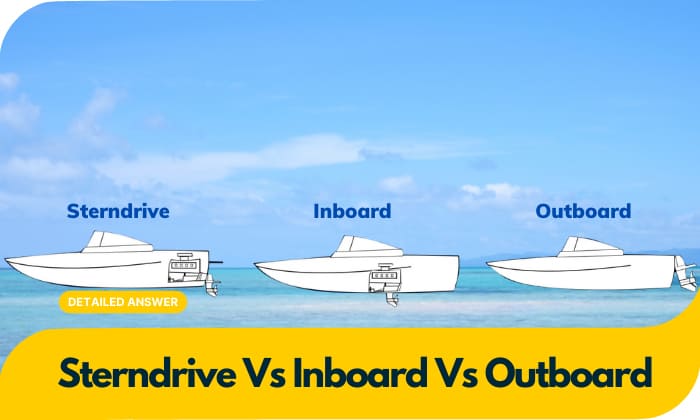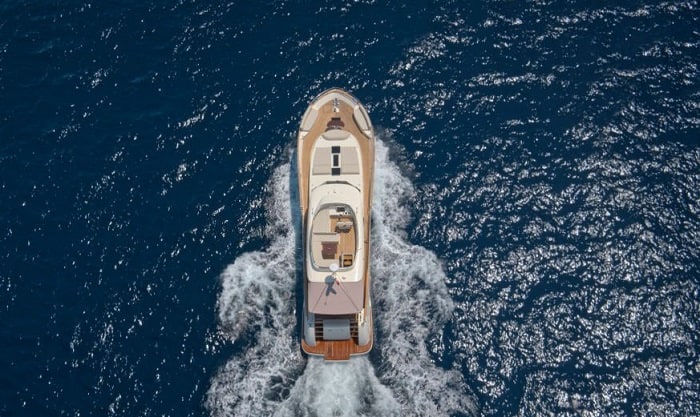
Boats move through the water using a wide range of propulsion systems. Drive-type jargon can be hard to understand—depending on which activities you prefer; even specific drive types have sub-variants that come with benefits and drawbacks.
Some drive types are good for water sports, while others are great at helping boaters fish in shallow water.
FIY, there are 5 types of boat drives: Inboard, Outboard, Inboard/Outboard (Stern drive), V-drive, and Jet drive. Let’s take a deeper look at the differences between sterndrive vs inboard vs outboard.
Table of Contents
Detailed Comparison: Inboard Vs Outboard Vs Sterndrive
1. Inboard
“Inboard”, meaning a marine propulsion system enclosed within a boat’s hull, is typically attached to a propulsion screw by a driveshaft. This driveshaft runs from the transmission to a propeller situated outside of a boat. When the captain turns the steering wheel, a rudder controls the boat’s direction.
Following that, the boat is turned by the propeller, pushing water past the turned rudder. The shaft connected to the engine turns the propeller after mounting an inboard motor by the stern or in the middle of your boat. Some inboard engines use an oil lubricant that boosts both engine performance and fuel efficiency.
Inboard vs. Sterndrive
Larger boats with inboard engines can provide a smooth and stable ride, while sterndrive boats offer one when trimmed up. Due to the boat’s reduced center of gravity as a result of the motor’s deep placement within the hull, stability is enhanced.
Inboard Pros & Cons
- Inboards have less drag, allowing them to go fast for a long time (ideal for water skiing). Furthermore, they are resistant to wear and tear. Inboards are easy to transport as well.
- On the downside, inboards are quite difficult to install because they require more space and a long shaft to propel the boat.
2. Outboard
One of the most used powered methods for propelling watercraft is the outboard motor.
It serves as a propulsion system for boats. There is more space left inside a boat with this engine than with inboard motors since it’s made to be mounted outside the boat, on the outside of the transom.
When air is compressed inside the engine’s cylinders, the pistons inside those cylinders move up and down. These pistons are joined to the crankshaft, which is mounted on an axis and spins around it as the pistons rise and fall inside the cylinder.
For your boat to move across the water, a propeller or other device that moves when your boat rotates pushes the water aside.
Outboard motors are available in 2- and 4-stroke varieties. These two models used to be much different from one another. The reliability, weight, speed, and fuel efficiency of current 2-and 4-stroke motors today are much more comparable thanks to technological advancements.
Outboard vs. Inboard Engine
- Inboard engines can occasionally be located in the center of a boat, and alternatively, on the stern. Outboard motors are always mounted outside the boat.
- In comparison to their outboard counterparts, inboard motors often last longer. Before needing maintenance, an inboard can run for around 1,500 hours. Outboards generally have a lifespan of 750 hours.
- Also, inboard options require less maintenance (almost half) despite being more pricey upfront.
Outboard Pros & Cons
- The horsepower rating of outboard motors may be lower than that of inboard engines. As a result of using less power to propel the boat, they may also use less gasoline.
They only take up a little room inside your boat too, which makes them ideal for smaller boats.
- In comparison to an inboard motor, outboard motors often operate loudly. They create a lot of noise when they are activated as well. Outboards may also consume more fuel if they have a high horsepower.
3. Sterndrive
Sterndrives are also referred to as inboards/outboards, but stern drive’s definition sets it apart. The main difference between sterndrive and inboard or outboard engines is that a sterndrive engine involves a system that combines the components of inboard and outboard systems.
Sterndrives use an inboard motor, sometimes a modified automobile engine, to propel the boat via a lower unit similar to an outboard motor.
Sterndrive Vs Inboard
Sterndrive and inboard engines provide a stable ride. However, a sterndrive boat will run faster than an inboard one with the same horsepower. An inboard engine will be easier to maintain than a sterndrive.
Sterndrive vs. Outboard
- Compared to outboards, sterndrives may cost you more to maintain but offer more access to a boat’s rear.
- Outboard motors require less maintenance over time as well. Moreover, outboards provide better economy thanks to their lighter overall package.
Stern Drive vs. V-Drive
Since they are incredibly flexible and maintain a clear, unobstructed transom, sterndrives have been widely used for a very long time.
On the flip side, the traditional “ski boat” inboard is given a twist by V-Drives, which also have a strong wake sports background but do not have a mid-engine that obstructs the cockpit.
Unlike sterndrives which lose 13 percent of their power when driving the prop, a V-drive is more efficient, losing only 8% of its power.
Nonetheless, a sterndrive is quicker and more fuel-efficient when all other factors are taken into account.
Sterndrive Pros & Cons
- Sterndrive benefits include having the lower unit trim adjustable like an outboard motor. It has an inboard engine that’s bigger and more powerful and performs better than an outboard. Furthermore, it provides greater room for seats and a larger rear platform because the engine is near the stern.
- Its drawback is how the bottom unit might get damaged by prolonged water exposure.
Frequently Asked Questions
Is Sterndrive Better Than Inboard?
It depends on preference, but a sterndrive is better if speed is important to you, while an inboard engine is best for you if you want less maintenance.
Is A Sterndrive The Same As An Outboard?
Sterndrive engines are made of both inboard and outboard systems. This is why a sterndrive is also referred to as inboard/outboard.
Conclusion
Sterndrives are also referred to as inboard/outboard, but there are key distinctions you have to be aware of.
A sterndrive has a system that combines the components of inboard and outboard systems and it can run faster with the same horsepower. Inboards are placed deep within a hull and provide more stability as well as require less maintenance, while outboards last longer and may use less gasoline.
Now, you can tell sterndrive vs inboard vs outboard!

Ten years of enjoying countless trips on boats never made me love them any less! So I am here to put all those experiences into good use for other boaters who want to have a safe and fun trip with their friends and families.




